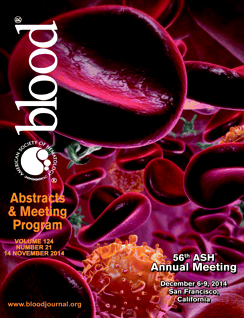Abstract
Background: Polycythemia vera (PV) is a myeloproliferative neoplasm defined by erythrocytosis; patients may also have increased platelets and white blood cells as well as splenomegaly and disease-related symptoms. JAK/STAT activation is the primary driver of PV pathogenesis, in most cases resulting from the JAK2V617F mutation. The RESPONSE trial compared ruxolitinib (RUX) and best available therapy (BAT) in patients with PV and splenomegaly who were intolerant of or resistant to hydroxyurea (HU) according to modified European LeukemiaNet criteria. At the time of the primary analysis, RUX demonstrated superior improvements in hematocrit (HCT) control, symptom burden, and spleen volume compared with BAT. This post hoc analysis of RESPONSE was conducted to determine if treatment outcomes were influenced by baseline spleen volume.
Methods: Patients with PV ≥18 years of age who were resistant to or intolerant of HU with palpable spleen (confirmed by MRI/CT to be ≥450 cm3) and phlebotomy requirement were randomized 1:1 to receive open-label RUX 10 mg BID or BAT. The primary endpoint was a composite that required a ≥35% reduction in spleen volume at Week 32 and hematocrit (HCT) control. HCT control was defined as lack of phlebotomy eligibility (based on HCT values) between Weeks 8–32 with no more than 1 phlebotomy eligibility between randomization and Week 8. A linear regression was conducted to determine the effect of baseline spleen volume on the percent change in spleen volume at Week 32. A logistic regression was conducted to determine the effect of baseline spleen volume on HCT control through Week 32. Spleen volume was measured by MRI at screening and Weeks 16 and 32. Hematocrit was assessed at screening, prerandomization, and every 2 weeks from Day 1 to Week 12, followed by every 4 weeks until Week 32.
Results:The RESPONSE trial enrolled 222 patients (RUX, 110; BAT, 112). Median (range) spleen volume at baseline was 1195 cm3 (396–4631 cm3) in the RUX arm and 1322 cm3 (254–5147 cm3) in the BAT arm. Baseline median (range) spleen length by palpation was 7.0 cm (0.0–24.0 cm) in the RUX arm and 7.0 cm (0.0–25.0 cm) in the BAT arm. In the 24 weeks prior to screening, most patients in both arms had ≥2 phlebotomy procedures (RUX, 87%; BAT, 80%). There was no correlation between the percentage change in spleen volume at Week 32 and baseline spleen volume; linear regression showed no significant effect of baseline spleen volume on the percentage change in spleen volume at Week 32 (P=0.40). No significant effect of baseline spleen volume on HCT control through Week 32 was identified based on logistic regression analysis (P=0.37).
Conclusion: In PV patients with inadequate response to or intolerant of HU, the degree of splenomegaly at baseline did not influence achievement of HCT control or reduction in spleen volume with RUX therapy.
Vannucchi:Novartis Pharmaceuticals: Honoraria, Membership on an entity's Board of Directors or advisory committees, Research Funding. Off Label Use: Ruxolitinib is a JAK1/JAK2 inhibitor approved for the treatment of patients with intermediate or high-risk myelofibrosis, including primary myelofibrosis, post polycythemia vera myelofibrosis, and post-essential thrombocythemia myelofibrosis. Verstovsek:Incyte Corporation: Research Funding. Jones:Incyte Corporation: Employment, Equity Ownership. He:Incyte Corporation: Employment, Equity Ownership. Li:Novartis Pharmaceuticals: Employment, Equity Ownership. Habr:Novartis Pharmaceuticals: Employment, Equity Ownership. Kiladjian:Novartis Pharmaceuticals: Honoraria, Membership on an entity's Board of Directors or advisory committees, Research Funding.
Author notes
Asterisk with author names denotes non-ASH members.

